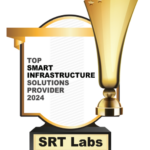
CIO Review Awards SRT Labs “Top Smart Infrastructure Solutions Provider” for 2024
August 1, 2024
VIPC’s Virginia Venture Partners Invests in SRT Labs to Scale All-in-One IoT Management Platform for Smart, Synchronous Systems Operations
October 9, 2024Demonstration of Long-Range Networking System Design Scheduled for Late August 2024
Springfield, Va. (Aug. 21, 2024) — Later this month, SRT Labs will run a signal test designed to demonstrate the feasibility of deploying a campus-wide environmental monitoring system that leverages LoRaWAN technology as a replacement for WiFi or cellular networks to span 150+ acres, paving the way for a lower cost, longer range solution on the campus to monitor environmental conditions and contaminants. The signal test will identify the appropriate hardware to ensure coverage for the campus that is to be monitored, which will provide positive ecological implications by increasing reaction time of management facilities to contaminant-related issues, as well as potentially informing similar rollouts on other campuses, bases, and local municipalities.
- Improved technology enables monitoring of remote environments. Improvements in LoRaWAN sensors have made it possible to deploy long-range networks without running cable or requiring access to regulated resources, allowing for the continuous monitoring of expansive environments.
- Immediate insights for regulatory compliance. Monitoring contaminant levels informs mitigation efforts, allowing organizations to stay in compliance with government issued regulations. Continuous monitoring allows teams to react immediately, saving money on larger mitigation efforts and fines.
- A model for cities and universities. The results of the signal test will validate the minimum viable system needed to support a sizable campus, the details of which will be made available to allow organizations with long-range monitoring needs to deploy similar environmental monitoring networks at a low cost.
If your campus or municipality is interested in long-range networks, please contact SRT Labs.
Gregory P. Scott, Ph.D., Chief Executive Officer of SRT Labs said: Partnering with this large campus to develop a long-range network will create a template for other campuses or even governments to monitor their own environments. This can provide invaluable data. Using this technology model, opens the possibility to monitor additional water conditions, air quality, traffic—or more—over vast distances.
Jens Fritzenwanker, Ph.D., Senior Solutions Architect of SRT Labs said: The technological advances allowing for monitoring conditions via a LoRaWAN network are key to span this distance. What makes LoRaWAN special is that it can penetrate concrete and other very dense structures in contrast to WiFi or Cellular. It is more cost efficient since a cellular data plan is only needed for the gateway and not each individual sensor like the new NB-IoT technology. LoRaWAN is ideal for situations where low sampling rates / infrequent communication to the web is needed.
About SRT Labs
SRT Labs brings essential legacy infrastructure into a unified data management ecosystem. Their integration framework, the M1 Platform, brings together collaborative robotics and smart sensors with existing software and hardware to monitor, analyze and automate systems. This single pane of glass dashboard means information from one system can automate actions in another. Real-time building health status allows for future-ready analytics, identifying and prioritizing areas for repair and predicting future failures. From building automation systems to automated warehouse technology and asset tracking, to environmental monitoring and building security, SRT Labs provides concise insights for decision makers and increases infrastructure readiness so that facility leaders can rely on effective and efficient systems.



